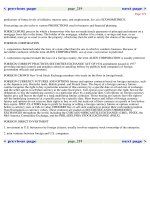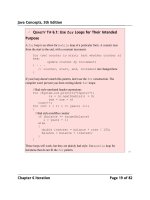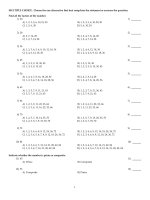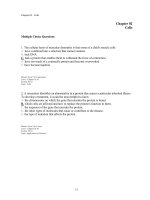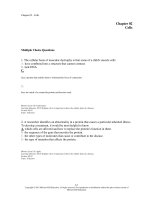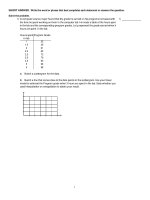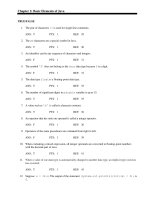Lecture Contemporary strategy analysis: Concepts, techniques, applications (5th edition): Chapter 4 - Robert M. Grant
Bạn đang xem bản rút gọn của tài liệu. Xem và tải ngay bản đầy đủ của tài liệu tại đây (281.28 KB, 7 trang )
<span class='text_page_counter'>(1)</span><div class='page_container' data-page=1>
<b>Further Topics in Industry </b>
<b>and Competitive Analysis </b>
<b>Further Topics in Industry </b>
<b>and Competitive Analysis </b>
<b><sub>Extending 5-forces analysis</sub></b>
<b>o Does industry matter?</b>
<b>o Complements</b>
<b>o Dynamic competition</b>
<b><sub>Game Theory</sub></b>
<b><sub>Competitor Analysis</sub></b>
<b><sub>Segmentation</sub></b>
<b><sub>Strategic Groups</sub></b>
</div>
<span class='text_page_counter'>(2)</span><div class='page_container' data-page=2>
<b>Does Industry Matter?</b>
<b>Does Industry Matter?</b>
<i><b>Percentage of variance in firms’ return on assets </b></i>
<i><b>explained by:</b></i>
<b>Industry </b>
<b>effects</b>
<b>Firm-specific </b>
<b>effects</b>
<b>Unexplained </b>
<b>variance</b>
<b>Schmalensee </b>
<b>(1985)</b>
<b>19.6%</b> <b>0.6%</b> <b>80.4%</b>
<b>Rumelt (1991)</b> <b>4.0%</b> <b>44.2%</b> <b>44.8%</b>
<b>McGahan & </b>
<b>Porter 1997)</b>
<b>18.7%</b> <b>31.7%</b> <b>48.4%</b>
<b>Hawawini et al </b>
<b>(2003)</b>
</div>
<span class='text_page_counter'>(3)</span><div class='page_container' data-page=3>
<b> The Value Net</b>
<b>The Value Net</b>
<b>COMPANY</b>
<b>CUSTOMERS</b>
<b>SUPPLIERS</b>
</div>
<span class='text_page_counter'>(4)</span><div class='page_container' data-page=4>
<b>SUPPLIERS</b>
<b>POTENTIAL</b>
<b>ENTRANTS</b>
<b>SUBSTITUTES</b>
<b>BUYERS</b>
<b>INDUSTRY</b>
<b>COMPETITORS</b>
<b>Rivalry among</b>
<b>existing firms</b>
<b>Bargaining power of suppliers</b>
<b>Bargaining power of buyers</b>
<b>Threat of</b>
<b>new entrants</b> <b>Threat of</b>
<b>substitutes</b>
<b>COMPLEMENTS</b>
<b>The suppliers of</b>
<b> complements create</b>
<b> value for the industry</b>
<b> and can exercise </b>
<b> bargaining power</b>
<b>Five Forces or Six? Introducing Complements</b>
</div>
<span class='text_page_counter'>(5)</span><div class='page_container' data-page=5>
<b>Dynamic Competition</b>
<b>Dynamic Competition</b>
<b>Porter framework assumes:</b>
<b>(a) industry structure drives competitive behavior</b>
<b>(b) Industry structure is (fairly) stable.</b>
<i><b>But, competition also changes industry structure:</b></i>
• <i><b>Schumpeterian Competition: A “perennial gale of creative </b></i>
<i><b>destruction” where firm strategies continually transforms industry </b></i>
<b>structure innovation overthrows established market leaders</b>
• <b>Hypercompetition: “intense and rapid competitive </b>
<b>moves….creating disequilibrium through continuously creating </b>
<b>new competitive advantages and destroying, obsolescing or </b>
<b>neutralizing opponents’ competitive advantages</b>
<i><b>Implication: Under dynamic competition, 5-forces framework is</b></i>
<b>less useful—Competitive behavior and industry structure jointly </b>
</div>
<span class='text_page_counter'>(6)</span><div class='page_container' data-page=6>
<b>The Contribution of Game Theory</b>
<b> to Competitive Analysis</b>
<b>The Contribution of Game Theory</b>
<b> to Competitive Analysis</b>
<i><b>Main value:</b></i>
<b>1.</b> <b>Framing strategic decisions as interactions between competitors</b>
<b>2.</b> <b>Predicting outcomes of competitive situations involving a few, </b>
<b>evenly-matched players</b>
<i><b>Some key concepts:</b></i>
<b>1.</b> <b>Competition and Cooperation—Game theory can show conditions</b>
<b>where cooperation more advantageous than competition</b>
<b>2.</b> <b>Deterrence—changing the payoffs in the game in order to deter</b>
<b>a competitor from certain actions</b>
<b>3.</b> <b>Commitment—irrevocable deployments of resources that </b>
<b>give creditability to threats</b>
<b>4.</b> <b>Signaling—communication to influence a competitor's decision</b>
<i><b>Problems of game theory:</b></i>
<b>Useful in explaining past competitive behavior—weak in predicting </b>
<b>future competitive behavior.</b>
</div>
<span class='text_page_counter'>(7)</span><div class='page_container' data-page=7>
<b> PREDICTIONS</b>
<b>• What strategy changes</b>
<b> will the competitor </b>
<b> initiate? </b>
<b>• How will the competitor </b>
<b> respond to our strategic</b>
<b> initiatives?</b>
<b>OBJECTIVES</b>
<b>What are competitor’s current goals?</b>
<b>Is performance meeting there goals?</b>
<b>How are its goals likely to change?</b>
<b>STRATEGY</b>
<b>How is the firm competing?</b>
<b>ASSUMPTIONS</b>
<b>What assumptions does the competitor</b>
<b>hold about the industry and itself?</b>
<b>RESOURCES & CAPABILITIES</b>
<b>What are the competitors’ key</b>
<b> strengths and weaknesses?</b>
</div>
<!--links-->
